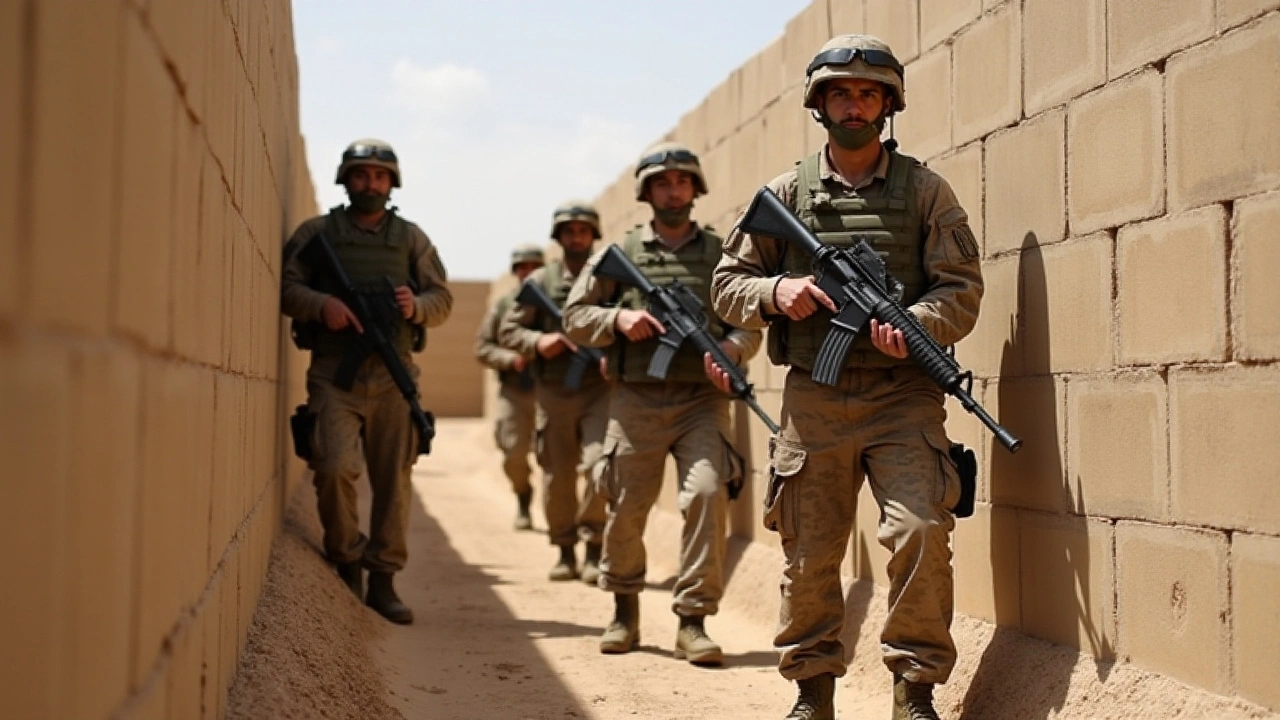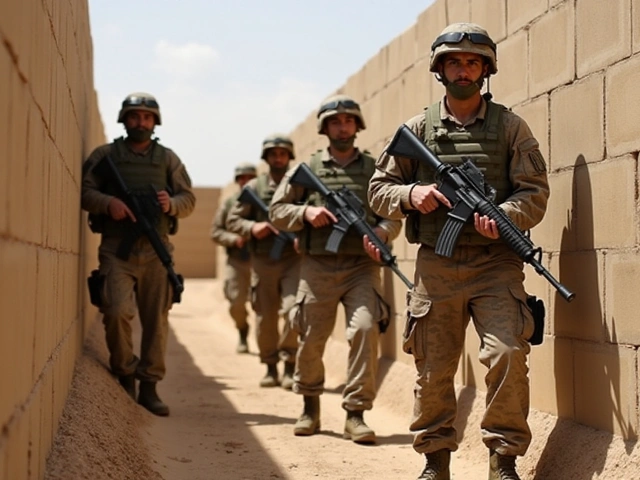
IDF's Strategic Deployment: What it Means for Gaza
The Israel Defense Forces (IDF) have recently deployed their 5th Brigade to the Netzarim Corridor in Gaza. This is a tactical decision in the grander scheme of the conflict between Israel and Hamas, which has been ongoing with varying intensities for several years. This corridor's strategic importance is underscored by its geographical relevance—it effectively cuts off Gaza City from the southern parts of the Gaza Strip. The 5th Brigade's presence here is therefore a critical move.
This deployment marks a continuity of military operations aimed at strengthening Israel's security stance around the Gaza Strip. The initial tasks of the brigade involved safeguarding Israeli communities in proximity to Gaza. In the initial days of conflict, ensuring the safety of these civilian populations was paramount. This approach reflects a broader strategy employed by the IDF, focusing on both offense and defense in handling the multiple complexities of this regional conflict.
Goals Behind the Deployment
The ultimate goal of Israel’s deployment in Gaza is to dismantle Hamas's military capabilities. By securing key positions like the Netzarim Corridor, the IDF can disrupt the logistical and operational capabilities of Hamas. This corridor, specifically, is a choke point that could hinder the free movement of goods and personnel, thereby delivering a blow to Hamas's operational efficiency.
Prime Minister Benjamin Netanyahu has also discussed a vision for Gaza's future that extends beyond the immediate military concerns. His outlined post-war framework includes the replacement of Hamas with a local civilian administration. Moreover, plans aim to demilitarize and deradicalize the region while maintaining strict Israeli security control. These are ambitious goals that could reshape the region’s socio-political landscape if fully realized. Yet, achieving such aims without maintaining a permanent Israeli military presence in Gaza poses a significant challenge.
Operational Challenges and Intelligence Gathering
The complexity of securing Gaza can’t be understated. One of the predominant challenges lies in ensuring stability without maintaining perpetual boots on the ground. The IDF has been working on partnering with local security forces to maintain law and order post-conflict. Success in these endeavors will mean a reduced need for an extensive Israeli presence while ensuring effective governance and peace enforcement.
Simultaneously, the IDF's operational efforts have included extensive intelligence-gathering missions. These missions involve targeting key Hamas leadership and strongholds, as well as capturing and interrogating militants. Confiscated documents and intelligence gathered through these methods have provided invaluable insights into the internal mechanisms of Hamas. This intelligence is crucial for preempting attacks and dismantling potential threats.
Current Status and Future Prospects
The current situation in Gaza remains intricate. While the IDF has made progress in curbing Hamas activities, the region still faces a potential for continued guerrilla warfare. Hamas has demonstrated its resilience and adaptability, often resorting to asymmetrical warfare tactics that complicate conventional military superiority. This ongoing threat underlines the necessity for a sustainable and comprehensive security solution that considers both military and socio-political dimensions.
The deployment of the 5th Brigade to the Netzarim Corridor is a critical step in Israel's broader strategy to control and secure the Gaza Strip. It ensures a tactical advantage and aids in severing key routes that might be utilized by Hamas. However, the future of Gaza depends not just on military might but on diplomatic strategies that can foster sustained peace and prosperity for the region. The path forward remains fraught with challenges, but every strategic move such as this brings a vision of long-term security one step closer.






While the strategic nuance of positioning the 5th Brigade in the Netzarim Corridor is evident, the broader implications for regional stability merit careful analysis.
Securing such a chokepoint can indeed limit hostile movements, yet lasting peace requires complementary diplomatic efforts.
It is essential to balance military objectives with humanitarian considerations to avoid exacerbating civilian hardships.
Thus, a measured approach that integrates security with constructive dialogue will be most effective.
The deployment, as delineated, underscores a meticulously crafted operational paradigm-one that intertwines kinetic precision with strategic foresight.
One cannot overlook the logistical intricacies inherent in asserting control over a corridor that bifurcates the Gaza Strip.
Indeed, the ramifications extend beyond mere territorial dominance, resonating within the intricate tapestry of geopolitics.
Moreover, the emphasis on intelligence gathering fortifies the overarching objective of preempting hostile contingencies.
Nevertheless, the ethical dimension of sustained military presence demands rigorous scrutiny.
In sum, this maneuver epitomizes a calculated exertion of force, albeit one shrouded in multifaceted consequences.
It is truly astonishing how the IDF’s latest maneuver appears to be a masterclass in modern military theater, where the notion of “strategic deployment” is wielded with the subtlety of a sledgehammer.
One must, of course, commend the sheer brilliance of selecting the Netzarim Corridor-a location whose logistical significance is as obvious as a neon sign in Times Square-thereby making the operation almost embarrassingly transparent.
Yet, beneath the veneer of tactical acumen lies an underlying assumption that force alone can engender lasting stability, a premise as naïve as believing that a single paper towel can mop up an ocean.
The rhetoric surrounding “dismantling Hamas’s capabilities” seems to hinge on the idea that cutting off a conduit will magically dissolve an entire ideological edifice, ignoring the complex socio‑economic roots that fuel such movements.
One could also point out the paradox of proclaiming a future “civilian administration” while simultaneously entrenching a permanent security apparatus, a contradiction that would make any seasoned diplomat wince.
Moreover, the notion of “partnering with local security forces” conveniently glosses over the historical mistrust that pervades those very relationships.
In an era where intelligence operations are touted as the linchpin of preemptive action, the reliance on intercepted documents and interrogations raises uncomfortable questions about privacy and due process.
One must also consider the ethical ramifications of alleged “extensive intelligence‑gathering missions” that may blur the line between legitimate security measures and invasive surveillance.
Furthermore, the chronic emphasis on “boot‑on‑the‑ground” solutions subtly insinuates that a perpetual military presence is both inevitable and desirable, a stance that seems at odds with any genuine aspiration for self‑determination.
The relentless focus on a “choke point” strategy appears to disregard the adaptive nature of asymmetric warfare, where adversaries routinely circumvent static obstacles with ingenuity.
It is, therefore, unsurprising that the piece acknowledges Hamas’s “resilience and adaptability,” yet offers little in the way of innovative countermeasures beyond conventional force projection.
One might argue that a sustainable resolution necessitates a blend of diplomatic engagement, economic development, and cultural reconciliation-components conspicuously absent from the current blueprint.
While the text exudes confidence in the efficacy of military dominance, history repeatedly illustrates that enduring peace is rarely forged through coercion alone.
In conclusion, the deployment of the 5th Brigade, though perhaps tactically sound, reads as a short‑sighted gambit that prioritizes immediate control over long‑term reconciliation.
Thus, the path forward demands a more nuanced, multidimensional strategy that transcends the simplistic equation of “security equals stability.”
Yo, so the 5th Brigade’s now chilling in Netzarim like it’s a secret base or sumthin, huh?
It’s wild how they think this’ll totally choke off Hamas, but you know they always got some wild backup plan.
Honestly, I can’t shake the feeling there’s some shadowy puppeteer pulling the strings behind the scenes.
All that intel talk sounds like a spy movie, but maybe there’s more to it than meets the eye.
Either way, brace yourselves, ‘cause the drama ain’t over yet.
Securing the corridor definitely sends a strong message, but it’s crucial we keep the civilian impact in mind.
Let’s hope any security gains translate into real safety for everyday people.
In the theater of war, each deployment is a stanza in an endless poem of power.
We witness the 5th Brigade carving verses upon the sands of Netzarim.
The echo will linger long after the guns fall silent.
Wow!!! This move is a game‑changer!!! 🎯🚀
It’s like the IDF just pressed “fast‑forward” on the whole security thing!!! 😲💥
Hope this actually brings some peace 🙏✨
We need less smoke and more clear skies!!! 🌤️💪
Stay safe out there, folks!!! 😁👍
Oh great, another “strategic” shuffle-because that’s worked out so well before.
Maybe this time they’ll actually solve the problem instead of just moving pieces on a board.
We’ll see, I guess.
The so‑called “strategic deployment” is nothing short of a blatant power grab, and it reeks of reckless arrogance.
You cannot simply blanket an entire region with military might and expect peace to materialize.
This heavy‑handed approach only fuels further animosity and entrenches the cycle of violence.
Enough with the hollow rhetoric; it’s time for genuine, accountable action.
Looks like the chessboard just got a new queen-let’s see how the other pieces react.
War’s a messy game, but sometimes a bold move shakes things up.
Balancing security with humanity is the real challenge.
Deploying the 5th Brigade into the Netzarim Corridor is a classic case of force projection intersecting with counter‑insurgency doctrine-basically, a high‑stakes maneuver that could recalibrate the threat matrix.
If we can synergize kinetic ops with robust civil‑military coordination, we might actually disrupt the adversarial network effects.
But without a comprehensive post‑conflict governance framework, all that firepower risks becoming a Pyrrhic victory.
Let’s keep the dialogue open and focus on building resilient institutions that outlast any temporary tactical gains.